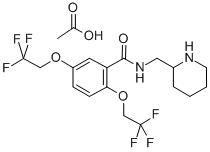54143-56-5
 54143-56-5 結(jié)構(gòu)式
54143-56-5 結(jié)構(gòu)式
基本信息
醋酸氟卡尼
醋酸洗必太
醋酸氟卡胺
氟卡尼醋酸鹽
醋酸氟卡尼 EP標(biāo)準(zhǔn)品
醋酸氟卡尼 USP標(biāo)準(zhǔn)品
氟卡尼系統(tǒng)適應(yīng)性 EP標(biāo)準(zhǔn)品
醋酸洗必太/ 醋酸氟卡尼/乙酸氟卡尼/ N-(哌啶-2-基甲基)-2,5-二(2,2,2-三氟乙氧基)苯甲酰胺乙酸鹽
r-818
Apocard
Ecrinal
Almarytm
Tambocor
Flucarney Acetate
FLECAINIDE ACETATE
Flecainide-d4 Acetate
Flecainide acetate CRS
物理化學(xué)性質(zhì)
安全數(shù)據(jù)
常見問題列表
Nav1.5 channel
Flecainide is a class 1C antiarrhythmic drug especially used for the management of supraventricular arrhythmia. Flecainide works by blocking the Nav1.5 sodium channel in the heart, causing prolongation of the cardiac action potential. in vitro: Under the current-clamp condition, flecainide (1-100 microM) prolonged the action potential duration at both the early and the late phases of repolarization in a concentration-dependent manner without affecting the resting membrane potential [1]. At a holding potential (HP) of -120 mV, flecainide use-dependently blocked WT and G1306E I(Na) equally but was more potent on R1448C channels. For WT, the extent of block depended on a holding voltage more negative than the activation threshold, being greater at -90 mV as compared to -120 and -180 mV [2]. in vivo: Flecainide (80-130 mg/m(2) orally) resulted in termination of the tachycardia in all 8 patients. Acute pharmacological termination of arrhythmia occurred with oral flecainide loading in 1 and temporarily with intravenous esmolol loading in 1 patient. Adjuvant therapy in form of propranolol was used in 5 and digoxin in 2 [3].

